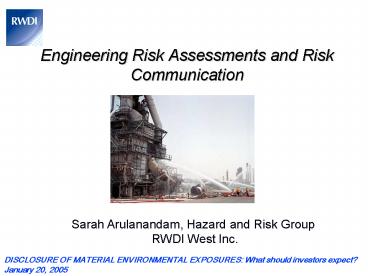Engineering Risk Assessments and Risk Communication - PowerPoint PPT Presentation
1 / 13
Title:
Engineering Risk Assessments and Risk Communication
Description:
Exposure to flame. Exposure to heat. Exposure to products. Flash ... Safety design and optimization. Recommendations for emergency planning zones and land-use ... – PowerPoint PPT presentation
Number of Views:101
Avg rating:3.0/5.0
Title: Engineering Risk Assessments and Risk Communication
1
Engineering Risk Assessments and Risk
Communication
Sarah Arulanandam, Hazard and Risk Group RWDI
West Inc.
DISCLOSURE OF MATERIAL ENVIRONMENTAL EXPOSURES
What should investors expect? January 20, 2005
2
Definitions of Risk
- Risk frequency x consequence
- Frequency accidental releases, upset conditions
- Consequences short-term, acute
- Risk exposure x effect
- Exposure low-level, continuous emissions
- Effect long-term chronic
- Risk frequency x consequence x outrage
- Outrage stakeholders, media, public, government
- Risk attractiveness of target x consequence
- Attractiveness likelihood of attack
- Risk ???
3
RISK BASED DECISIONS
- TECHNOLOGY SELECTION
- Design Construction Standards
- Control Options
- Accident, Mitigation Recovery Options
- RISK ASSESSMENT
- Public Involvement
- Guidelines Standards
- Risk Utility
- Risk Acceptability
- Risk Communication
RISK MANAGEMENT
- HAZARD ANALYSIS
- Hazard Identification
- Source Term Modelling
- Dispersion Modelling Forecasting
- Receptor Response Modelling
- RISK ANALYSIS
- Employee and Worker Safety
- Public Safety
- Environmental
- Financial
- FREQUENCY ANALYSIS
- Historical Accident Incident Data
- Predictive Failure Models
- Event Tree Analysis
- Fault Tree Analysis
4
Steps Involved in Hazard and Risk Management
- Identify the hazards
- Define the system and characterize the source
- Conduct dispersion modelling
- Estimate the consequences
- Compare hazard results to accepted public health
and safety criteria - Review the options for managing the hazards
- Examine failure frequencies and event
probabilities - Estimate the risk
- Compare risk results to accepted risk criteria
- Review the options for managing and reducing the
hazards and risks (i.e., alternate design and
operating parameters, and accident control,
reduction and mitigation strategies)
5
Threat Spectrum(Courtesy of DND)
Greatest
Radio- Isotopes
Nuclear Weapons
- Most Likely High Yield Explosive (HYE)
- Most Dangerous Nuclear Weapons
- -----------------------------------------
- Greatest Threat Contagious Biological Pathogen
Least
6
Example Hazard Identification
Immediate ignition
- Jet Fire
- Exposure to flame
- Exposure to heat
- Exposure to products
Delayed ignition
- Flash Fire
- Initial exposure (toxicity)
- Exposure to flame
- Exposure to heat
- Exposure to products
Uncontrolled release
No immediate ignition
No ignition
- Dispersing plume
- Exposure (toxicity)
7
Safety Design and Optimization
- Compare alternative designs
- Assess control systems and operational parameters
- Compare risks to accepted standards
Generate alternatives and implementation
strategies
8
Emergency Planning
- Recommendations for emergency planning zones and
land-use - Understand the nature and extent of the hazard
- Select the level of protection required
- Define an emergency planning zone (EPZ)
- Communicate findings
9
Example Health and Safety Planning Priorities
Potential release source
Advance warning of an accident?
Area where other impacts may be experienced
Accident occurs
Plume disperses
- Area where chronic effects may be experienced
- Public health response area(shared
responsibilities) - Selection of health criteria
Exposure to dispersing plume
- Area where acute effects may be experienced
- Emergency Response Plan (responsibility of
company) - Selection of EPZ criteria
10
Public Involvement and Communications
- Present an understanding of the hazards and risks
at public meetings - Preparation of materials for presentation to
stakeholders - Regulatory applications and expert testimony
- Corporate due-diligence and policy development
11
Forensic Incident Analysis
- Accident investigation and reporting
- Describe the system
- Evaluate the meteorology during the event
- Recreate the incident
- What happened?
- Who was affected?
12
Applications Hazard and Risk Assessments
- Safety design and optimization
- Recommendations for emergency planning zones and
land-use - Public involvement and communications
- Regulatory applications and expert testimony
- Corporate due-diligence policy
- Accident investigation and reporting
13
The Heinrich Pyramid
Accidents
Incidents
Unreported Occurrences































